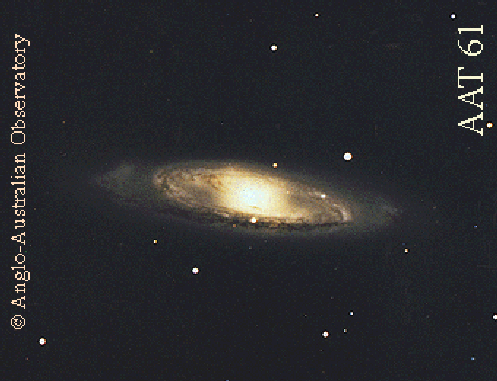Astronomy Picture of the Day
Discover the cosmos!
Each day a different image or photograph of our fascinating universe is
featured, along with a brief explanation written by a professional
astronomer.
August 12, 1996

Leo Triplet Spiral Galaxy M65
Credit:
Anglo-Australian Telescope
photograph by David Malin
Copyright:
Anglo-Australian Telescope
Board
Explanation:
Spiral galaxy M65 is a normal spiral galaxy not unlike our own Milky Way.
In fact,
M65
is a typical
spiral galaxy of a type that could be found
anywhere in the local universe. Given a morphological type of "Sa", M65
shows tightly wrapped spiral arms and a large nuclear central bulge. The
central bulge stars are older and redder than disk stars, which appear more
blue. Stars in the bulge of the our own
Milky Way Galaxy are also
typically older and redder than stars in the disk where our
Sun resides. M65 is a member of the
Leo
Triplet of galaxies, along with its neighbors
M66 and
NGC
3628. Although it appears that M65's gravity has distorted M66's
symmetry, M65's symmetry seems unaffected by M66. M65 is located roughly 35
million light years away, so that light recorded today left after the fall
of the dinosaurs but when many land mammals were just evolving on
Earth.
Tomorrow's picture: Europa's Surface
| Archive
| Index
| Search
| Glossary
| Education
| About APOD |




Authors & editors:
Robert Nemiroff
(MTU) &
Jerry
Bonnell (USRA).
NASA Technical Rep.:
Sherri
Calvo.
Specific rights apply.
A service of:
LHEA
at
NASA/
GSFC




